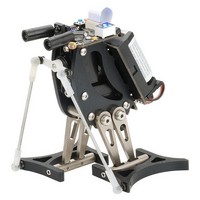27316 Parallax Inc, 27316 Datasheet - Page 17

27316
Manufacturer Part Number
27316
Description
Microcontroller Modules & Accessories Penguin Robot BLACK
Manufacturer
Parallax Inc
Datasheet
1.27316.pdf
(24 pages)
Specifications of 27316
Product
Microcontroller Accessories
Core Processor
2PX24 Stamp
Lead Free Status / RoHS Status
Lead free / RoHS Compliant
2.3. MECHANICAL TROUBLESHOOTING GUIDE
The Penguin is made from CNC-machined aluminum, molded plastic, screw-machine shoulder bolts, and
a variety of electronic components from different factories. There’s always the possibility that something
will go wrong and parts will bind or move with limited freedom – it’s nearly impossible to test every single
sub-assembly. For example, tolerances on the shoulder screws and plastic sockets can vary from batch to
batch or a shoulder screw bolt could have a slightly larger diameter shaft. It is imperative that your
Penguin operate smoothly and without friction to be an effective walker. Contact us if you have any
problems. Below are examples of common Penguin assembly difficulties and solutions to them.
Copyright © Parallax, Inc. • Penguin (#27313-27316) • v1.0 7/12/2007
Problem
Ball link sockets
are tight or
binding.
Legs move too
much from left
to right.
Ankles are too
tight within the
feet.
Legs are too
tight against the
body.
Explanation
The ball link sockets are molded parts and they
may vary in tolerance though we’ve chosen a
supplier that offers a consistent product. The
socket and ball should move freely without any
friction when assembled. If you need to loosen
up tight-fitting ball links:
(a) Use an X-Acto knife to remove any plastic
burrs inside the plastic socket.
(b) Add a drop of oil into the socket.
(c) Reassemble the ball links and check for
friction.
Pressing the left and right legs together should
create no more than 1/8” to ¼” of movement (or
“slop” as it is called by a machinist). If a
particular leg seems to have too much side-to-
side play, you can fix this by tightening the
shoulder screw down another ¼ turn. If the
problem persists, you can gently chamfer the
threaded body panel with a drill to sink the
shoulder screw further into the body. Be careful
if you choose this option because you can
remove too much metal and the leg will tighten
against the body!
The ankles are the 1¼” long by ¼” diameter
round standoff with two channels machined
between. The legs are pinned in these
channels. If the round ankle binds inside the
foot, slightly shorten the ankle by rubbing the
end of it on a piece of sandpaper. Insert the leg
assembly back into the foot and check the fit.
The correct adjustment for the legs depends on
the shoulder screws being tightened gently. If
the leg is binding against the body, back off the
shoulder screws so it can move. Use a dab of
Loc-Tite on the threads of the shoulder screw
so it stays screwed into position in the body
panel.
Picture
Page 17 of 24




















